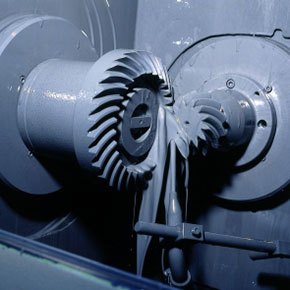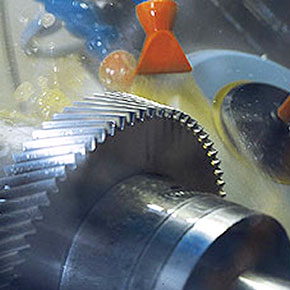Gear Lapping & Grinding


After a gear is manufactured, it may still need to be finished in order to improve the surface finish and dimensional accuracy. A gear may be finished in several different ways, such as gear lapping or grinding.
Gear lapping is the process of imparting a very fine finish and high degree of accuracy to gear teeth, by using a lapping tool and applying a fine-grained abrasive between a work material and a closely fitting surface, called a lapping plate. By running mating pairs together in a gear lapping machine and feeding a liquid abrasive compound under pressure into the gear pair, small amounts of metal are removed as the gears rotate, thus refining the tooth surface and achieving the desired contact pattern.

Lapping typically improves the wear properties of gear teeth, and corrects the minute errors in involute profile, helix angle, tooth spacing and concentricity created in the forming, cutting or in the heat treatment of the gears. Therefore, gear lapping is most often applied to sets of hardened gears that must run silently in service. It is important to bear in mind that gear lapping is a mating process; two gears that have been matched by lapping should be operated as a set, and also replaced as a set, rather than singly.
Gear teeth can be produced entirely by grinding, entirely by cutting, or by first cutting and then grinding to the required dimensions. Usually, gear grinding is performed after a gear has been cut and heat-treated to a high hardness; grinding is necessary for parts above 350 HB (38 HRC), where cutting becomes very difficult. Teeth made by grinding are usually those of fine pitch, where the amount of metal removed is very small. In addition, grinding of gears becomes the procedure of choice in the case of fully hardened steels, where it may be difficult to keep the heat-treat distortion of a gear within acceptable limits. Lastly, in a few cases, medium-hard gears that could be finished by cutting are ground in order to save costs on expensive cutting tools such as hobs, shapers or shaving cutters, or to get a desired surface finish or accuracy on a difficult-to-manufacture gear.

The two basic methods for gear grinding are form grinding (non-generating) and generation grinding. Form grinders use a disc wheel to grind both sides of the space between two gear teeth, and have an involute form dressed into the side of the wheel; a generating grinding wheel, on the other hand, is straight-sided.
The major disadvantage of grinding gears vs cutting is their cost. Due to the fact that materials must be removed in small increments when grinding as compared to cutting, the former is more expensive. In addition, ground gears attract more inspection than cut gears, and may involve both magnetic particle inspection as well as macroetching with dilute nitic acid.
